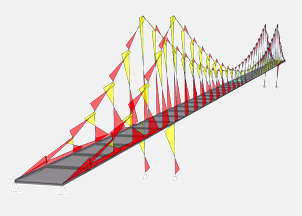This space is devoted to CSiBridge. Please visit the Technical Knowledge Base for documentation on topics common to all
CSI
Software.
|
CSiBridge Topics
Recommended publication
|
|
- Unknown macro: {new-tab-link}1
Guidelines for Nonlinear Analysis of Bridge Structures in California
CSiBridge is software produced specifically for the engineering of bridge systems. Engineers may use CSiBridge to model and design suspension, cable-stay, elevated roadway, and any other type of bridge system such that it may suit any one of a variety of purposes, including means for crossing water, linking points between shear terrain, or extending over highway infrastructure.
|
|
Modeling of Bridge Systems
CSiBridge implements a parametric object-based modeling approach when developing analytical bridge systems. This enables designers to assign bridge composition as an assembly of objects (roadway superstructure, substructure, abutments, piers, foundation system, etc.) before the SAPFire ® Analysis Engine, integral to
CSI
Software, automatically transfers the object-based model into a mathematical finite-element model by meshing the material domain and assigning material properties. This object-oriented approach simplifies and expedites the modeling process, saving engineers the need to directly define, link, constrain, and mesh all material volumes.
CSiBridge also allows engineers to import model data from Dwg/Dxf, IGES, CIS/2 STEP, and Land XML file formats, or export to PERFORM-3D, MS Access, and CIS/2 STEP, all following
IFC
standards.
Loading and Analysis
|
|
|
|
After modeling, CSiBridge provides options for the assignment of load cases and combinations. Vehicle, seismic, and wind loading are generated according to building code (AASHTO LRFD, Canadian, etc.) and assigned according to model geometry. A series of templates for assigning and enveloping load conditions make CSiBridge intuitive and practical.
After the original object-based model has been translated into a finite-element model and subjected to load cases and combinations, the analysis process follows directly.
Analysis capabilities go well beyond elastic performance into the assessment of inelastic behaviors. Geometric and material nonlinearities provide insight into strength, ductility, and other performance measures critical to response under extreme loading. Static-pushover and dynamic analyses (steady-state, response-spectrum, and time-history) provide further insight into earthquake resilience. Substructure hinging properties are customizable.
|
Additional analysis features may account for creep and shrinkage behavior, post-tensioning with optional automatic cable tensioning, staged-construction effects inherent to segmental construction, buckling, camber and shape finding.
|
|
|
Design and Output
An automatic design process couples with analysis procedures to coordinate and optimize the resizing of bridge components. For reinforced-concrete systems, CSiBridge optimizes rebar sizing through a comparable procedure.
Customizable reports present analysis and design details in a variety of formats. Moment, shear, and axial response data and diagrams in 2D and 3D views, seismic-displacement capacity, demand-capacity ratio, load rating per classification, influence-surface plots for displacement, reaction, and frame, shell, solid, or link response are all options for output generation.
CSiBridge Tutorials
CSiBridge Test Problems
References
- [1] –
Unknown macro: {new-tab-link}. Guidelines for Nonlinear Analysis of Bridge Structures in California. Berkeley, CA: Pacific Earthquake Engineering Research (PEER) Center.
Aviram, A., Mackie, K., Stojadinovic, B. (2008)
